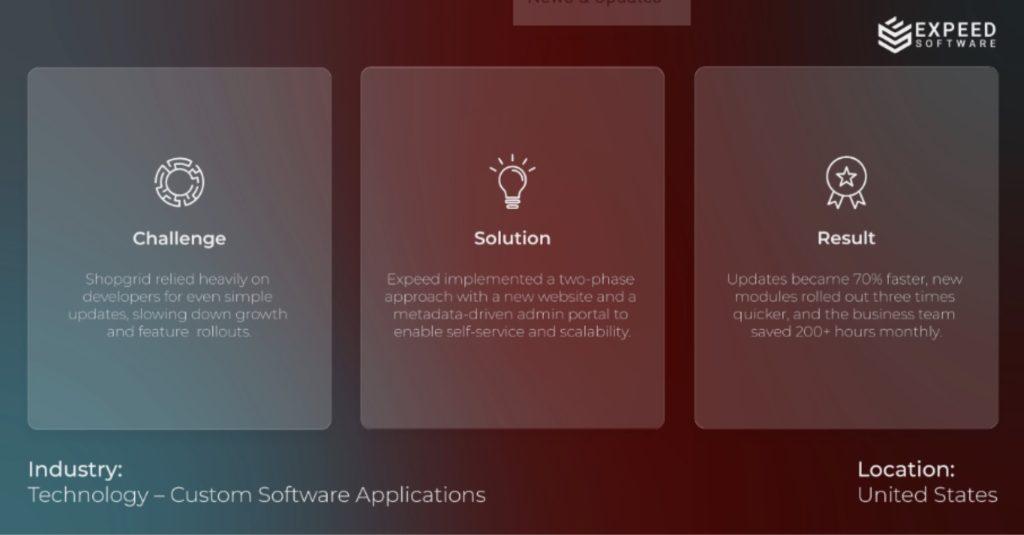By Expeed Software
This case study examines how Shopgrid modernized its internal systems with the assistance of Expeed Software to reduce reliance on developers and boost business expansion. The solution streamlined feature rollouts, increased operational efficiency, and provided Shopgrid with the flexibility to scale without technical bottlenecks by combining a metadata-driven framework with a phased strategy.

The Problem
As it grew, Shopgrid, a technology company that creates cloud apps and customized solutions, sought to fortify its digital systems. Developer participation was necessary for even minor adjustments like adding a page or a menu. Although this strategy had previously been effective, as the company expanded and the need for new features increased, it became more and more time-consuming.
Shopgrid’s management began to realize that the company’s next phase of expansion required more adaptability. They wanted their internal team to be able to handle updates on their own, lessen the need for technical support for regular adjustments, and ensure that the systems could grow with the company.
The Plan
To meet these demands, Expeed Software suggested a two-stage strategy. The first stage was designed to give Shopgrid a solid online presence and a platform for digital interaction. In addition to building the foundation for more sophisticated capabilities, this established the brand in the marketplace.
The creation of a dynamic admin portal was the main goal of the second phase. This metadata-driven framework allowed the system to quickly adjust to new needs. The framework could dynamically generate modules, menus, pages, and controls. Expeed used this same metadata structure to store data in the database and to render pages based on APIs. To maintain uniform layouts across all modules and make management easier for the client’s team, reusable user interface controls were implemented.
Scalability was considered when designing the framework. In addition to meeting immediate needs, it provided a framework for upcoming improvements and project reuse.
The Findings
Operational Efficiency
- Turnaround Time for Updates
Before: 3–5 days (developer dependency) → After: < 1 day (self-managed)
- Reduction in Developer Involvement
Approximately 70% fewer developer hours required for routine updates such as menus and pages
- Number of Updates Managed by Business Team
On average, 25–30 updates are now managed independently by the business team each month
Feature Release Velocity
- Time-to-Market for New Modules
Before: 2–3 weeks → After: 3–5 days with the metadata-driven framework
- Increase in Release Frequency
Module rollout became 3x faster compared to the earlier process
- Cycle Time per Release
The average cycle reduced from ~18 days to ~5 days from idea to deployment
Consistency & Quality
- UI/UX Consistency Score
95% compliance with design standards achieved through reusable UI controls
- Error/Defect Rate
Inconsistencies across pages dropped by ~60% after standardization
Scalability
- Modules/Pages Added Without Redevelopment
More than 20 new modules and pages were added in the first year without major redevelopment
- System Scalability Index
Year-over-year growth in business demands supports zero redesigns of the core system
Cost & Resource Optimization
- Maintenance Effort Reduction
Approx. 40% fewer developer hours spent on maintenance tasks
- Cost Savings
Estimated savings of $35K–$40K annually by reducing repetitive coding and support needs
- Reallocation of Technical Resources.
More than 50% of developer effort was redirected from routine maintenance to strategic projects
Business Impact
- Team Satisfaction Score
Internal feedback showed ~90% satisfaction among business users due to increased independence
- Confidence to Scale
All new business demands in the past year were met without delays caused by technical bottlenecks
- Time Saved
An estimated 200+ man-hours saved per month through business self-service and faster rollouts
The Takeaway
Expeed Software worked with Shopgrid to move from a developer-dependent model to a metadata-driven framework that empowered the internal team. The two-phase approach delivered both a robust online presence and a dynamic portal that combined independence, speed, scalability, consistency, and reduced maintenance effort.
By aligning technology with Shopgrid’s growth objectives, Expeed provided a solution that delivered immediate business value while establishing a foundation for long-term expansion.




